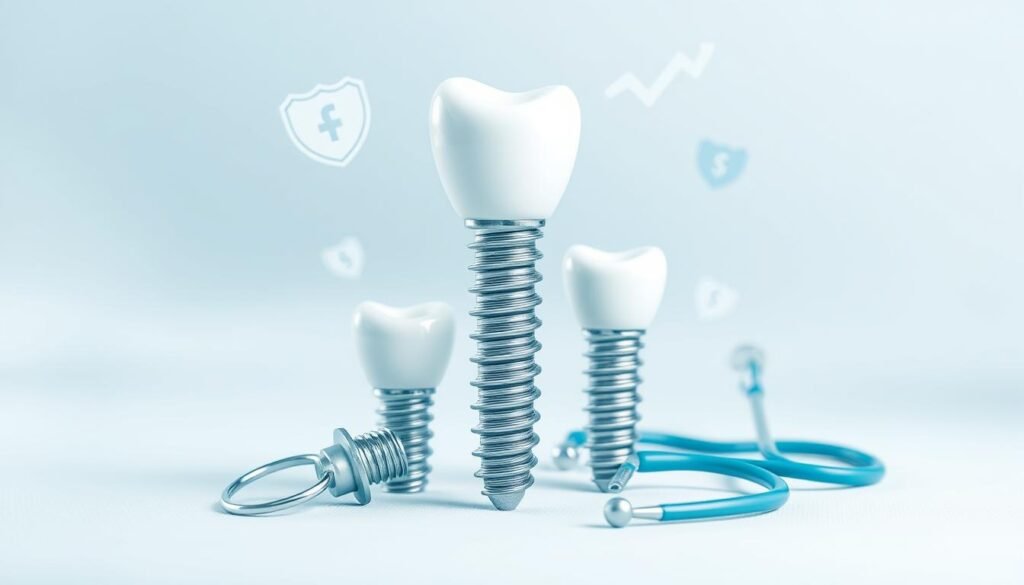Dental implants are the most durable solution for replacing missing teeth and restoring chewing, speech, and confidence. While upfront costs can be significant, the American Dental Association (ADA) reports typical implant costs are in the $3,000–$5,000 range per tooth (2024 data), and medical insurance may cover implants in specific medically necessary situations.
Most dental insurance plans still treat implants as restorative or cosmetic and limit coverage, but medical insurance (including some private plans and Medicare Advantage) can pay when implants are required for medical reasons — for example after trauma, tumor removal, or reconstructive surgery. This guide explains how to increase your chances to get implants covered by medical insurance, what documentation insurers look for, and practical next steps to protect your smile and your finances.
Quick action: Talk to your dentist and insurance provider about pre-authorization and request a medical necessity letter to start the process.
Table of Contents
ToggleKey Points;
- Most dental plans exclude implants: Many insurers treat implants as restorative or cosmetic, so standard dental insurance often provides little or no coverage — check your policy for exclusions (examples: Delta Dental, Cigna).
- Typical cost (ADA 2024): Expect about $3,000–$5,000 per implant; out-of-pocket can be much higher for full-arch work.
- Medical insurance may cover implants when medically necessary: Coverage is possible after trauma, tumor removal, or reconstructive jaw surgery — ask whether your case qualifies under medical insurance or Medicare Advantage.
- Use tax-advantaged accounts and supplemental options: HSAs/FSAs can pay eligible implant-related costs (per IRS rules); supplemental dental plans or third‑party financing can reduce upfront costs.
- Documentation and pre-authorization are critical: A medical necessity letter, treatment plan, X-rays/CBCT, and itemized estimates improve approval odds — gather records early.
- Quick action: Gather your medical/dental records, request a medical necessity letter from your dentist, and submit a pre-authorization request to your insurance provider.
Overview of the dental implant process and its costs
Dental implants are the leading long-term solution for replacing missing teeth, restoring function and appearance by anchoring a prosthetic tooth directly into the jawbone. A typical implant system has three main parts: the implant body (a titanium post placed into the bone), the abutment (connector), and the crown (the visible tooth replacement).
- How they work: The implant integrates with the jawbone (osseointegration) to provide a stable foundation that mimics the structure of natural teeth.
- Main benefits: Improved chewing, clearer speech, jawbone preservation, and a more confident smile.
Cost varies by location, implant type, and additional procedures (bone grafts, sinus lifts, lab fees). According to ADA data (2024-2025), expect roughly $3,000–$5,000 per dental implant for a single-tooth restoration; full‑arch restorations can be substantially higher depending on the approach. Exact figures should be confirmed with your dentist.
Many patients use Health Savings Accounts (HSAs) or Flexible Spending Accounts (FSAs) to pay eligible implant-related expenses (check IRS rules and your plan for eligibility). When implants are medically necessary—for example after trauma or tumor removal—medical insurance may contribute; see the “How to get dental implants covered by medical insurance” section for documentation and billing tips.
Quick example: A 45-year-old with a single missing molar who secures pre-authorization and uses HSA funds may reduce immediate out-of-pocket costs significantly—ask your provider for an itemized estimate to plan financing.
The Dental Implant Process
The dental implant process has several steps, each with its own price tag. These steps include:
- First, you’ll have a consultation with a dentist or oral surgeon.
- Then, if needed, the dentist will remove the damaged or missing tooth.
- Next, a titanium implant is placed in the jawbone.
- After that, you’ll wait for the implant to bond with the bone (osseointegration).
- Finally, the abutment and custom-made crown or restoration are attached.
Why Dental Implants Can Be Costly
The dental implant cost reflects multiple components: the implant fixture, abutment, crown, surgical fees, imaging, and any adjunctive procedures such as bone grafts or sinus lifts. According to the American Dental Association (ADA) 2024 data, a typical single-tooth dental implant runs about $3,000–$5,000, though fees vary by region and complexity; full-arch restorations are substantially more.
Key cost drivers include:
- Number and type of implants: single-tooth vs. multiple implants or full-arch solutions
- Additional procedures: bone grafting, sinus lifts, extractions, or jaw reconstruction
- Imaging and lab fees: CBCT scans and custom prosthetics increase expenses
- Facility and anesthesia: hospital or surgical center fees for complex cases
- Provider expertise and materials: implant system and clinician experience
Many dental insurance plans either exclude implants or limit coverage because insurers classify them as restorative or elective. Medical insurance may cover implant-related procedures when they are billed as medically necessary (for example after trauma, tumor resection, or reconstructive jaw surgery) — check policies from major carriers (Cigna, Aetna, Delta Dental) for specifics.
Also be aware that routine dental plans often have annual maximums (commonly in the $1,000–$1,500 range for many policies). That means even if part of an implant is covered, out-of-pocket costs can remain high. If cost is a concern, ask your dental office for an itemized estimate and a written treatment plan you can submit to insurers for pre-authorization.
We understand implants are a major financial decision. Practical next steps: request multiple quotes, confirm which parts of treatment (surgery, bone graft, crown) may qualify under medical insurance, and explore HSA/FSA use or supplemental plans to manage costs.
Medical vs. Dental Insurance
Video: Understanding when oral procedures fall under medical vs. dental coverage (embed or watch for examples of trauma and reconstructive cases)
It’s important to understand the difference between medical insurance and dental insurance because coverage rules, billing, and prior‑authorization processes differ significantly. Dental insurance typically covers preventive care (cleanings, exams) and limited restorative procedures (fillings, crowns) under annual benefit limits. Medical insurance is designed for illnesses, injuries, and reconstructive procedures — and it may cover oral surgery or implants when the treatment is deemed medically necessary.
Common scenarios where medical insurance may contribute to implant-related costs include trauma (facial or jaw injuries), tumor or cancer resections requiring reconstruction, congenital defects, or jaw reconstruction that affects overall health or function. Major carriers (for example, Cigna and Aetna) and Medicare Advantage plans will sometimes cover implant-related procedures when coded and documented as medically necessary — always verify with your specific insurance provider and plan.
Note on costs: reported out-of-pocket figures can vary widely because some published numbers reflect patient payments after partial coverage or bundled services. For consistent planning use ADA 2024 averages (~$3,000–$5,000 per implant) and confirm estimated patient responsibility with your dentist and insurer.
At-a-glance: Medical vs. Dental
- Dental insurance: Covers routine dental care and many restorative procedures; often excludes implants or places them in a cosmetic/exclusion category; lower deductibles but annual maximums.
- Medical insurance: May cover oral surgery, bone grafting, or implants when tied to a medical diagnosis (trauma, cancer reconstruction, congenital conditions); higher deductibles but potential for broader coverage.
Practical tip: If you believe your case may qualify for medical coverage, ask your dentist to prepare a detailed treatment plan, a medical necessity letter, and include relevant ICD‑10/CPT codes when submitting for pre-authorization. If you have Medicare, remember Original Medicare generally excludes routine dental — but some Medicare Advantage plans may cover reconstructive oral procedures; check plan documents carefully.
How to get dental implants covered by medical insurance
Getting implants paid for by medical insurance requires preparation and a clear demonstration of medical necessity. Follow a checklist approach: document the problem, secure clinical justification, submit a pre-authorization with correct codes, and be prepared to appeal if denied.
Determine Medical Necessity
Medical necessity is the single most important factor in whether medical insurance will cover implants. Typical qualifying reasons include traumatic injury to the jaw/face, tumor or cancer resections requiring reconstruction, congenital defects, or medically necessary jaw reconstruction that restores function (chewing, speech, airway). Ask your dentist and treating physician to clearly explain how the implant is required to treat a medical condition, not purely cosmetic concerns.
Common billing examples: insurers evaluate documentation tied to ICD‑10 diagnosis codes (e.g., trauma, neoplasm) and relevant procedure codes — work with your billing team to include appropriate ICD‑10/CPT or CDT codes on pre‑auth requests.
Collect Required Documentation
Assemble a complete packet before submitting a claim or pre-authorization. A well-documented submission improves the chance of approval.
- Medical necessity letter: a signed letter from your dentist and/or surgeon explaining the medical reason for implants and the expected health benefit.
- Treatment plan: itemized estimate with costs for each component (extraction, bone graft, implant placement, abutment, crown).
- Imaging: X‑rays, panoramic films, and CBCT scans showing bone loss, pathology, or trauma.
- Clinical records: operative notes, pathology reports (if tumor or cancer treatment), and prior treatment history.
- Photographs: intraoral and extraoral photos demonstrating functional impact.
Author note (15+ years insurance experience): Insurers look for objective evidence (imaging, pathology, documented functional deficit). Vague statements like “improves appearance” rarely persuade medical payers.
Engage in the Pre-Authorization Process
Always request pre-authorization before proceeding when possible. Pre-authulation gives you clarity on what the insurance provider may cover and reduces surprise bills.
Include the full documentation packet, itemized costs, and the suggested billing codes. Ask the insurer for a written pre-authorization decision and keep the reference number and contact names.
Sample coverage examples — varies by plan
| Procedure | Possible Coverage (varies) | Notes |
| Tooth extraction | Often covered by dental; medical coverage possible if part of reconstructive surgery | Submit operative note |
| Bone grafting | Sometimes covered if required for reconstruction | Provide imaging and graft justification |
| Implant placement (fixture) | May be covered when billed as reconstructive medical procedure | Requires medical necessity letter and pre-auth |
| Prosthetic crown | Often dental benefit; medical rarely covers crown alone | Include prosthetic plan and cost split |
Common documents checklist: medical necessity letter, itemized estimate, imaging (CBCT/X‑ray), clinical notes, photographs, and applicable diagnosis/procedure codes.
Appeals and Next Steps
If your claim is denied, follow the insurer’s appeal process immediately: request a written denial, obtain the insurer’s appeals form, and submit an appeal with additional supporting documentation (detailed physician letters, operative reports, peer-reviewed literature if relevant). Track timelines (first-level appeal 30–60 days typical; request external review if available). Keep detailed notes of all calls—date, time, and representative name.
Quick action: Ask your dentist to prepare a medical necessity letter with specific ICD‑10/CPT/CDT codes and to submit a pre-authorization packet; contact your insurer to confirm required documentation and appeals procedures before treatment. way to replace missing teeth. They help restore your smile’s look and function.
How to get dental implants covered by medical insurance
Getting implants paid for by medical insurance requires preparation and a clear demonstration of medical necessity. Follow a checklist approach: document the problem, secure clinical justification, submit a pre-authorization with correct codes, and be prepared to appeal if denied.
Determine Medical Necessity
Medical necessity is the single most important factor in whether medical insurance will cover implants. Typical qualifying reasons include traumatic injury to the jaw/face, tumor or cancer resections requiring reconstruction, congenital defects, or medically necessary jaw reconstruction that restores function (chewing, speech, airway). Ask your dentist and treating physician to clearly explain how the implant is required to treat a medical condition, not purely cosmetic concerns.
Common billing examples: insurers evaluate documentation tied to ICD‑10 diagnosis codes (e.g., trauma, neoplasm) and relevant procedure codes — work with your billing team to include appropriate ICD‑10/CPT or CDT codes on pre‑auth requests.
Collect Required Documentation
Assemble a complete packet before submitting a claim or pre-authorization. A well-documented submission improves the chance of approval.
- Medical necessity letter: a signed letter from your dentist and/or surgeon explaining the medical reason for implants and the expected health benefit.
- Treatment plan: itemized estimate with costs for each component (extraction, bone graft, implant placement, abutment, crown).
- Imaging: X‑rays, panoramic films, and CBCT scans showing bone loss, pathology, or trauma.
- Clinical records: operative notes, pathology reports (if tumor or cancer treatment), and prior treatment history.
- Photographs: intraoral and extraoral photos demonstrating functional impact.
Author note (15+ years insurance experience): Insurers look for objective evidence (imaging, pathology, documented functional deficit). Vague statements like “improves appearance” rarely persuade medical payers.
Engage in the Pre-Authorization Process
Always request pre-authorization before proceeding when possible. Pre-authulation gives you clarity on what the insurance provider may cover and reduces surprise bills.
Include the full documentation packet, itemized costs, and the suggested billing codes. Ask the insurer for a written pre-authorization decision and keep the reference number and contact names.
Sample coverage examples — varies by plan
| Procedure | Possible Coverage (varies) | Notes |
| Tooth extraction | Often covered by dental; medical coverage possible if part of reconstructive surgery | Submit operative note |
| Bone grafting | Sometimes covered if required for reconstruction | Provide imaging and graft justification |
| Implant placement (fixture) | May be covered when billed as reconstructive medical procedure | Requires medical necessity letter and pre-auth |
| Prosthetic crown | Often dental benefit; medical rarely covers crown alone | Include prosthetic plan and cost split |
Common documents checklist: medical necessity letter, itemized estimate, imaging (CBCT/X‑ray), clinical notes, photographs, and applicable diagnosis/procedure codes.
Appeals and Next Steps
If your claim is denied, follow the insurer’s appeal process immediately: request a written denial, obtain the insurer’s appeals form, and submit an appeal with additional supporting documentation (detailed physician letters, operative reports, peer-reviewed literature if relevant). Track timelines (first-level appeal 30–60 days typical; request external review if available). Keep detailed notes of all calls—date, time, and representative name.
Quick CTA: Ask your dentist to prepare a medical necessity letter with specific ICD‑10/CPT/CDT codes and to submit a pre-authorization packet; contact your insurer to confirm required documentation and appeals procedures before treatment.
Factors Affecting Dental Implant Coverage
Several policy and plan features determine whether your dental implants will receive insurance coverage. Understanding these factors—waiting periods, annual maximums, exclusions, and plan type—helps patients anticipate costs and prepare stronger coverage requests.
Waiting Periods
Many dental plans include waiting periods before covering major restorative procedures; these can range from a few months up to a year depending on the insurer and the specific plan. Medical plans may not have the same waiting rules for medically necessary reconstructive care, but you should confirm exact timelines with your insurance provider.
Limits and Exclusions
Annual maximums and explicit exclusions are common. Typical dental annual maximums often fall in the $1,000–$1,500 range for basic plans, meaning even partial coverage for an implant may leave a large out-of-pocket balance. Exclusions for implants are frequently written into policy language (classified as cosmetic or elective). Always read your policy or ask your insurer for a benefits confirmation in writing.
Insurance Policy Variations
Coverage varies widely between insurance policies and providers. Employer-sponsored plans, individual dental policies, Medicaid, Medicare Advantage, and private medical insurers each apply different rules. For example, some Aetna and Cigna plans may cover parts of reconstructive procedures when properly documented as medically necessary, while many Medicaid programs limit adult dental benefits—state rules differ significantly.
Practical Checklist — Questions to Ask Your Insurer
- Is there a waiting period for implant-related procedures, and how long is it?
- What is my annual maximum and how does it apply to multi-step implant treatment?
- Does the plan exclude implants as cosmetic or elective?
- What documentation is required to consider an implant medically necessary (medical necessity letter, ICD‑10/CPT/CDT codes, imaging)?
- If denied, what is the appeals process and timeline (including external review rights)?
Tip: Keep a policy benefits summary and call notes (date/time/representative) in your treatment file. Link this to the appeals guidance in the “How to get dental implants covered by medical insurance” section.
How to Maximize Your Insurance Benefits
To reduce out-of-pocket costs for dental implants, create a coordinated plan that combines your insurance knowledge, professional support, and financing options. Understanding your policy and working proactively with your dentist and insurer unlocks the best possible insurance coverage and payment strategies.
Understand Your Policy Details
Read your plan documents or call your insurance provider to confirm: coverage percentages, deductibles, annual maximums, waiting periods, and exclusions for implants. Example: if a plan covers 50% of implant placement but 70% of the crown, use an itemized estimate to calculate your expected costs and how much you can pay with an HSA/FSA.
Consult with Dental and Insurance Professionals
Ask your dental team to prepare an itemized treatment plan with procedure codes (CDT/CPT/ICD‑10) and to help submit a pre-authorization. Use this script when calling your insurer: “Please confirm in writing whether my plan will cover [procedure code] for [diagnosis code], the required documentation for medical necessity, and whether a prior authorization is needed.” Keep names and reference numbers for all calls.
Explore Supplemental Coverage Options
Consider supplemental dental plans that explicitly list restorative/implant benefits, but read exclusions carefully—policies vary (check carriers like Delta Dental, Cigna for plan examples). HSAs and FSAs are commonly allowed to pay eligible implant-related expenses per IRS rules—confirm with your HSA/FSA administrator. If immediate cash flow is a concern, third-party financing (CareCredit, LendingClub) offers payment plans; typical APRs vary widely, so compare terms and calculate total repayment before you commit.
| Insurance Option | Description | How it helps |
| Primary Medical/Dental Plan | Employer or individual coverage for routine and medical procedures | May cover parts of reconstructive procedures when medically necessary |
| Supplemental Dental | Additional policy focused on restorative/cosmetic treatments | Can increase coverage for implants or reduce out-of-pocket |
| HSA / FSA | Tax-advantaged accounts for qualified medical expenses | Reduces immediate patient costs; check eligibility for implants |
| Third-Party Financing | Credit plans for healthcare expenses | Spreads payments; watch APR and total cost |
Checklist — Ask your dentist for:
- An itemized estimate breaking out extraction, bone grafting, implant fixture, abutment, and crown
- Relevant procedure and diagnosis codes (CDT/CPT/ICD‑10)
- A medical necessity letter tailored to your insurer’s criteria
Small investments in documentation and communication can yield large savings. Combine policy knowledge, a strong treatment packet, HSA/FSA usage, and careful financing to maximize benefits and make implants more affordable.
Exploring Alternatives to Dental Implants
If dental implants are out of reach financially or medically, there are reliable alternatives. Dental bridges and dentures are the most common options — each offers trade-offs in cost, function, and long‑term dental care.
Dental Bridges
Dental bridges replace one or more adjacent missing teeth by anchoring crowns to neighboring natural teeth. Costs vary by materials and region; typical ranges reported by dental clinics are roughly $1,500–$5,000 depending on complexity. Bridges are often covered more readily by dental insurance than implants because plans treat them as a standard restorative option. Who should consider a bridge: patients with healthy adjacent teeth and who prefer a faster, less invasive solution than implants.
Dentures
Dentures are removable prosthetics that replace several or all teeth. Basic partial dentures can cost a few hundred dollars, while more customized, higher‑quality full dentures range from about $700–$3,500 or more. Dentures are generally the least expensive option up front, and many dental plans provide coverage for portions of denture treatment. Who should consider dentures: those needing an affordable, non‑surgical solution or patients who are not candidates for implants due to health or bone limitations.
| Type | Typical Cost Range | Longevity | Who it’s best for |
| Dental Bridges | $1,500–$5,000 | 5–15 years (with maintenance) | Patients with strong adjacent teeth who want a fixed solution |
| Dentures | $700–$3,500+ | 5–10 years (depends on fit & wear) | Patients seeking a lower-cost, non-surgical option |
| Dental Implants | $3,000–$5,000 per tooth (ADA 2024) | 10+ years; often decades with good care | Patients seeking a durable, natural-feeling solution |
Long-term cost comparison: while bridges and dentures can cost less upfront, implants often last longer and may be more cost‑effective over a decade or more. Check your dentist and insurer: bridges and dentures commonly receive better dental insurance coverage than implants, so your best value may depend on your plan and clinical needs. Talk with your dentist about which option best fits your oral health, budget, and desired outcome for your smile.
Maximizing Your Dental Benefits

Understanding dental insurance can be tough. But, with smart strategies, you can get more from your coverage. This section will show you how to use your dental benefits wisely. We’ll also talk about combining dental and medical insurance to save money.
Leveraging Dental Insurance Coverage
To get the most from your dental insurance, know your plan well. Look at your policy for coverage limits, deductibles, and what’s not covered. Some plans cover more for medically necessary procedures.
Work with your dentist to prove the implant is needed. This can help you get more from your insurance.
Combining Dental and Medical Insurance
Dental implants might be covered by your medical insurance if they’re for a medical reason. Combining dental and medical benefits can lower your costs. Your dentist and insurance can work together to find the best coverage.
| Benefit | Dental Insurance | Medical Insurance |
|---|---|---|
| Coverage for Dental Implants | Varies by plan, often limited | May cover if deemed medically necessary |
| Deductible | Typically lower than medical deductible | Generally higher than dental deductible |
| Out-of-Pocket Maximum | Often lower than medical out-of-pocket max | Typically higher than dental out-of-pocket max |
Knowing your dental and medical insurance can help you save. By using both wisely, you can get more benefits. This way, you’ll spend less on maximizing dental insurance benefits, combining dental and medical insurance for dental implants, and reducing out-of-pocket expenses for dental implants.
Coordinating Medical and Dental Insurance
Understanding how medical and dental insurance work together for dental implants is key. Knowing the roles of each policy helps you get the most coverage and save money.
Primary and Secondary Insurance Coverage
Your dental insurance usually covers dental implants first. This means your dental insurer pays claims first. Your medical insurance might help if your dental plan runs out or if implants are medically necessary.
It’s vital to know what each policy covers. This helps you use all the benefits you can get.
Strategies for Coordinating Coverage
- Work closely with your dentist and insurance providers to determine the primary and secondary roles of each policy.
- Obtain pre-authorizations from both your dental and medical insurers to ensure that the coordinating medical and dental insurance for dental implants is approved.
- Provide detailed documentation, such as x-rays and medical records, to support the primary and secondary insurance coverage for dental implants.
- Be persistent in following up with your insurers and advocating for the coverage you are entitled to.
By working together with your insurance, you can get the most out of your dental implant treatment. This can greatly reduce the cost of your care.
Exploring Financing Options
Dental implants can be expensive, especially without good dental insurance. But, there are ways to make them more affordable. Let’s look at some options you might find helpful.
Payment Plans and Dental Financing
Dental offices often have payment plans or work with financing companies. These plans let you pay a bit each month. This way, you don’t have to pay everything at once.
Dental Implant Loans
Dental loans are another choice. They’re loans just for dental work, like implants. These loans usually have good rates and flexible payback plans.
Supplementing Insurance with Financing
If insurance doesn’t cover all the cost, you can use financing too. This mix lets you use your insurance and still pay for the rest. It makes implants more doable and cheaper.
| Financing Option | Advantages | Considerations |
|---|---|---|
| In-House Payment Plans |
|
|
| Dental Implant Loans |
|
|
| Combining Insurance and Financing |
|
|
Looking into these options can help you find a way to afford dental implants. Even with limited insurance, you can still get the treatment you need.
Step-by-Step Process of Obtaining Dental Implants
Knowing each step of the implant process helps you plan clinically and financially. Below is a practical timeline, what to expect at each step, and the documentation to save for insurance claims.
Initial Consultation and Assessment
At the first step, your dentist or oral surgeon examines your mouth, reviews medical history, and orders imaging (panoramic X-ray or CBCT). The team evaluates bone volume, adjacent teeth, and overall oral health to determine if you are a candidate. Expect a discussion of treatment options, estimated cost, and recommended referrals (prosthodontist or ENT/oncologist when medical issues are present).
Treatment Planning
The treatment plan lays out the full procedure sequence, timeline, and an itemized estimate. This is the document insurers want for pre-authorization: include ICD‑10 diagnosis codes and CDT/CPT procedure codes, an itemized cost breakdown (extraction, bone graft, implant fixture, abutment, crown), and projected dates for each stage.
Procedure Steps
Typical clinical steps (may vary by case):
- Tooth extraction (if needed) — may be same-day or staged.
- Bone grafting / sinus lift — when jawbone needs augmentation; healing may be required before implant placement.
- Implant placement (fixture) — titanium post placed into the jawbone.
- Osseointegration — the implant fuses with bone; commonly 3–6 months but can vary with site and grafting.
- Abutment connection — connector placed after integration.
- Crown placement — final prosthetic tooth attached.
Timeframe: from consultation to final crown typically ranges from 3 months (simpler cases) to 9+ months (with grafting or complex reconstruction).
Post-Operative Care
After each surgical visit follow instructions for hygiene, diet, and medications. Schedule follow-ups to confirm healing. Long-term maintenance includes regular checkups and excellent oral hygiene to preserve implant health.
Step Checklist for Insurance Claims
- Initial consultation notes and imaging (panoramic/CBCT)
- Detailed treatment plan and itemized estimate
- Medical necessity letter (if seeking medical insurance coverage)
- Operative reports and pathology reports (when applicable)
- Post-op notes and receipts for HSA/FSA reimbursement
Codes & Team Roles (examples)
Ask your provider for the exact CDT/CPT and ICD‑10 codes they will use — common examples include extraction and grafting CDT codes and surgical CPT codes for oral procedures. Your treatment team may include a general dentist, oral surgeon, and prosthodontist; involve medical specialists (ENT, oncologist) when implants are part of broader medical reconstruction.
Keeping a clear paper trail aligned with each clinical step improves your chance of medical or dental coverage and simplifies appeals if needed.
Common Challenges Faced
Patient discussing insurance denial for dental implant coverage with dentist
Many patients encounter obstacles when trying to secure insurance coverage for dental implants. The most common issues are claim denials for lack of medical necessity, confusion over whether a procedure should be billed to medical or dental insurance, and plan limits that leave large out-of-pocket balances.
Dental implants use titanium fixtures that integrate with the jawbone and have high long-term success rates (see ADA/Mayo Clinic for clinical outcomes). Still, insurers frequently classify implants as elective or cosmetic under routine dental plans, which creates financial hurdles for patients.
| Challenge | Description | Potential Solution |
| Insurance claim denials | Claims may be denied for perceived lack of medical necessity or incomplete documentation. | Submit a detailed medical necessity letter, imaging, operative notes, and an itemized treatment plan; request pre-authorization before treatment. |
| Policy confusion & exclusions | Patients often don’t realize implants are explicitly excluded or capped in their policy language. | Review your insurance policy or request a benefits confirmation in writing; ask your insurer which ICD‑10/CPT/CDT codes they will accept for medical coverage. |
| Annual maximums / limits | Dental plans commonly have annual caps that quickly get exhausted by implant procedures. | Explore supplemental coverage, HSA/FSA use, or staged treatment to manage annual maximums; obtain multiple itemized quotes. |
How to appeal a denial — step by step
- Request the denial in writing immediately and note the reason(s) given.
- Ask your insurer for the appeals form and submission deadlines.
- Gather additional evidence: expanded medical necessity letters (physician + surgeon), pre- and post-op imaging, operative/pathology reports, and peer-reviewed literature supporting medical necessity if applicable.
- Submit first-level appeal with a clear timeline and all supporting documents; keep copies and log all communications (date, rep name, reference number).
- If the first appeal is denied, seek external review or state insurance consumer protection resources (deadlines and availability vary by state and plan).
Real patient example: An anonymized case: a patient in Texas had implants initially denied after a car accident; after submitting a surgeon’s medical necessity letter, CT images, and operative notes showing reconstructive need, the insurer approved coverage as reconstructive surgery rather than elective dentistry.
If you receive a denial, act quickly: request the written denial reason and appeals form, collect the documentation above, and submit a timed, documented appeal. Contact your dentist’s billing team for help preparing codes and supporting clinical records.
Benefits of Getting Dental Implants
Dental implants offer strong clinical and quality‑of‑life advantages compared with other tooth‑replacement options. Implants restore chewing and speaking function, preserve jawbone health by stimulating bone maintenance, and provide a natural-looking tooth replacement that supports long-term oral health and confidence.
Evidence-based outcomes show high success rates: many studies and ADA guidance report implant survival rates well above 90% at 10 years when placed and maintained properly (source: ADA / peer-reviewed literature). While no medical device is truly permanent for every patient, implants are long‑lasting and often function for decades with proper care.
| Benefit | Description |
| Restored functionality | Improves chewing and speech, allowing better nutrition and daily comfort. |
| Jawbone preservation | Implants stimulate bone and reduce the bone loss that follows tooth loss. |
| Enhanced self‑esteem | A stable, natural-looking smile can boost confidence and social engagement. |
| Long‑term value | Though initial costs are higher, implants may be more cost‑effective over many years due to durability and fewer replacements. |
| Potential insurance support | When implants are medically necessary (trauma, reconstructive surgery), medical insurance may cover part or all of the procedure—document benefits carefully. |
Patient snapshot: one patient who lost front teeth in an accident reported restored eating ability and regained confidence after reconstructive implant therapy was approved by their insurer following submission of CT imaging and a surgeon’s medical necessity letter.
Tip for claims: include functional and health benefits (improved nutrition, prevention of further bone loss, restoration of airway/function if relevant) in medical necessity letters to strengthen insurance appeals.of documenting the medical necessity of implants.
Getting dental implants covered by insurance is easier with good documentation. This paperwork is key to your claim. It helps your insurance cover the cost you need.
Insurance companies look at medical necessity for dental implants. Showing why you need implants helps. It proves they’re for health, not just looks.
- Medical conditions that may qualify dental implants as a medical necessity include:
- Severe tooth loss due to injury or illness
- Certain developmental or congenital defects affecting the teeth or jaw
Facial trauma resulting in tooth loss
- Documentation should include:
- Detailed medical history and diagnosis
- Comprehensive treatment plan
- X-rays, scans, and other diagnostic imaging
- Letters of medical necessity from your dentist and any relevant specialists
With strong documentation, you show your insurance why implants are needed. This can help your claim get approved. It saves you time, stress, and money.
“Proper documentation is the key to unlocking insurance coverage for dental implants. It’s the foundation upon which your case for medical necessity must be built.”
Types of documentation insurance companies typically require (x-rays, medical history).
When you want insurance for dental implants, you need the right papers. Insurance companies want proof that the implants are needed. Let’s look at what they usually ask for.
X-Rays and Diagnostic Imaging
X-rays and scans like CT or CBCT are key. They show the dentist’s office what’s going on in your mouth. This helps the insurance company see why you need implants.
Medical History
Your medical history is also important. It talks about any health issues, past dental work, and why you might need implants. This could be because of an injury, disease, or birth defect.
Detailed Treatment Plan
A detailed plan from your dentist or surgeon is vital. It should explain the steps of the implant process, when it will happen, and what you can expect. This plan is about your health and how implants will help.
Letter of Medical Necessity
A letter from your dentist or surgeon can really help. It should explain why you need implants, how they’ll help your health, and what benefits they’ll bring.
| Documentation Type | Description |
|---|---|
| X-Rays and Diagnostic Imaging | Detailed x-rays, CT scans, and CBCT scans to assess the condition of the patient’s oral health and the need for dental implants. |
| Medical History | Comprehensive details about any underlying medical conditions, previous dental treatments, and factors contributing to the need for implants. |
| Detailed Treatment Plan | A well-structured plan outlining the steps, timeline, and expected outcomes of the dental implant procedure. |
| Letter of Medical Necessity | A letter from the treating dentist or oral surgeon explaining the medical rationale and the impact on the patient’s health. |
By giving these documents, you can make a strong case for dental implants. This can help you get insurance coverage. Always work with your dental team to make sure your application is complete and strong.
Writing a Letter of Medical Necessity

If you want your dental implants covered by insurance, a good letter of medical necessity is key. This letter helps convince your insurance that the treatment is needed. Here are some tips to write a strong letter for dental implants.
Tips for a Compelling Letter of Medical Necessity
- Clearly Explain the Medical Necessity: Tell why dental implants are a must for you. Share your oral health history, any injuries, and how implants will help your health and life quality.
- Highlight the Impact on Your Health: Show how not having implants could harm your oral health more. Explain how implants will stop these problems and make you healthier.
- Use Objective Medical Evidence: Back up your points with medical records like X-rays and dental reports. This shows your treatment is really needed.
- Keep it Concise and Organized: Make your letter easy to read. Use bullet points or lists to get your points across. Keep it short and to the point.
By using these tips, you can write a strong letter. This will help you get your dental implants covered by insurance. Clear and detailed writing, along with good evidence, are key to a successful letter.
“A well-written letter of medical necessity can be the difference between getting your dental implants covered or having to pay out-of-pocket.”
Preparing for Insurance Claims
Dealing with insurance claims for dental implants can be tough. But, with the right steps, you can do well. Before you submit your claim, make sure you’re ready.
Steps to Take Before Submitting a Claim
- Gather all important documents: Get x-rays, medical records, and any other proof that shows you need dental implants.
- Make a detailed treatment plan: Work with your dentist to plan your treatment. This should include what you’ll do, what you hope to achieve, and how it will help your health.
- Get pre-authorization: Call your insurance company to get approval for your dental implant procedure. This can help your claim get approved.
- Check your policy: Read your insurance policy well. Know what’s covered, what’s not, and any rules about dental implants.
Common Mistakes to Avoid When Filing Claims
- Not providing enough evidence: Insurance needs a lot of proof that dental implants are necessary. Not giving them enough can cause your claim to be denied.
- Not getting pre-authorization: Many insurance companies need approval before they cover dental implants. Not getting this can mean your claim is rejected.
- Submitting wrong or incomplete claims: Make sure your claim form is right and has all the info it needs. This helps avoid delays or rejections.
- Waiting too long to file a claim: Most insurance policies have a time limit for filing claims. If you miss this, your claim might be denied.
By following these steps and avoiding common mistakes, you can prepare well for insurance claims. This increases your chances of getting your dental implants covered. Remember, being patient and persistent is important when dealing with insurance for dental implants.
Gathering Necessary Documentation
Understanding dental implant insurance claims can be tough. You need to keep good records and know what documents are needed. A checklist helps make sure you have everything for a successful claim.
Checklist for Dental Implant Insurance Claims
- Detailed treatment plan from your dentist, outlining the medical necessity of the dental implants
- X-rays and other diagnostic imaging, such as CT scans or panoramic images, to support the need for implants
- Medical records, including any relevant prior dental or medical treatments or conditions that contributed to the need for implants
- Proof of the cost of the dental implant procedure, including a detailed breakdown of the charges
- Letter of medical necessity, written by your dentist, explaining the rationale for the implants and how they would improve your overall oral health and function
Keeping good records is very important for dental implant claims. By keeping detailed records and staying organized, you can improve your chances of getting your implants covered.
| Document | Purpose |
|---|---|
| Treatment Plan | Outlines the medical necessity and details of the dental implant procedure |
| Diagnostic Imaging | Provides visual evidence to support the need for implants |
| Medical Records | Demonstrates any pre-existing conditions or prior treatments related to the need for implants |
| Cost Breakdown | Ensures the insurance provider has a clear understanding of the financial aspects of the procedure |
| Letter of Medical Necessity | Provides a detailed justification from your dentist for the medical necessity of the implants |
By following this checklist of required documents and keeping good records, you can better navigate the insurance process. This increases your chances of getting the coverage you need for your dental implants.
“Proper documentation is the key to a successful insurance claim for dental implants. Neglecting to gather and organize the necessary records can significantly delay or even jeopardize the approval process.”
Conclusion
Dental implants can restore function, preserve jawbone structure, and significantly improve quality of life for people with missing teeth. While implants are often excluded by routine dental plans, medical insurance may cover them when they are documented as medically necessary (for example, after trauma, tumor resection, or reconstructive jaw surgery).
Success depends on preparation: assemble thorough documentation, request pre-authorization, and work closely with your dentist and insurance provider to submit a clear medical necessity case. Consider HSA/FSA funds, supplemental plans, or financing to bridge gaps in coverage.
Next steps: Ask your dentist for an itemized treatment plan and medical necessity letter, call your insurance provider to confirm required documentation and appeals procedures, and obtain a written pre-authorization when possible.
Updated 2025 — [Author], 15+ years in medical and dental insurance consulting. Resources: ADA, Mayo Clinic, Delta Dental, Cigna, Aetna.










